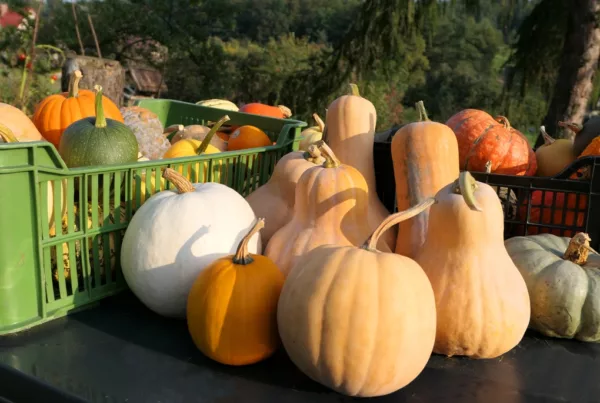Ready to add some zing to your garden? Go beyond the expected parsley, sage, rosemary, and thyme, by planting these five flavor-packed herbs in your Square Foot Garden herb bed. Most are perennials, so be mindful of which bed you choose and plant any perennials into a Square Foot Garden that isn’t disturbed (replanted) every year. In fact, perennials like these five herbs are just one great reason to have several garden beds (as if you needed a reason to plant more!).
Great herbs for your Square Foot Garden
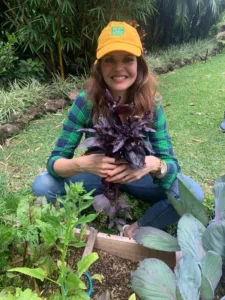
You’re not going a bouquet of herbs like this in a store! Paz Jimenez shows her Square Foot Garden-grown purple basil.
Purple Basil
Purple basil (Ocimum basicilum var. purpurascens) is a cultivar of sweet basil (Ocimum basilicum). Like common basil, purple basil is an annual herb. It’s easy to grow, and its glowing, purple leaves are striking in the garden. Purple basil offers beauty and substance. If you favor a bit of spice in your pesto or salads, purple basil is your herb. Its strong clove-like flavor makes it a favorite addition to artisan vinegars and oils, and the bold look doubles as a handsome garnish, too. Purple basil grows 18 – 24 inches tall (45 – 60 cm). So, plant one per square foot.
Mexican tarragon
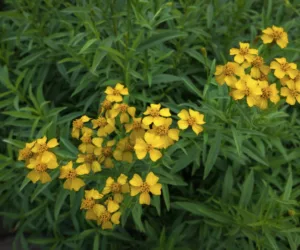 Mexican tarragon (Tagetes lucida) tastes much like French tarragon but with an additional anise flavor that it’s often used as a substitute. But that’s where the similarities end as Mexican tarragon is not a tarragon at all, but instead, is related to marigolds. Like many vegetables and herbs, it is a perennial plant in its native home, but is grown as an annual in cold winter areas. Even as a perennial, it may go dormant for the winter. Pair it with fish dishes, soups, sauces, and hot cocoa to take advantage of its sweet anise flavor. Mexican tarragon grows 2 feet tall and wide (60 cm), so plant one per square foot.
Mexican tarragon (Tagetes lucida) tastes much like French tarragon but with an additional anise flavor that it’s often used as a substitute. But that’s where the similarities end as Mexican tarragon is not a tarragon at all, but instead, is related to marigolds. Like many vegetables and herbs, it is a perennial plant in its native home, but is grown as an annual in cold winter areas. Even as a perennial, it may go dormant for the winter. Pair it with fish dishes, soups, sauces, and hot cocoa to take advantage of its sweet anise flavor. Mexican tarragon grows 2 feet tall and wide (60 cm), so plant one per square foot.
Stevia
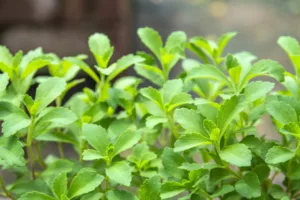 Stevia (Stevia rebaudiana) is a tender perennial that loves nothing more than hot weather. Plant them when both day and night temperatures are above 50 degrees. Stevia leaves are hundreds of times sweeter than sugar. You can steep the leaves in tea for a natural sweetener. September to October is the time to harvest the stevia leaves. When the flower buds appear and just before the flowers open, the entire plant should be harvested. If you live in a mild winter area, leave six inches at the bottom of the plant so it can regrow next year. Stevia grows 2’ feet tall and wide (60 cm), so one plant per square is appropriate.
Stevia (Stevia rebaudiana) is a tender perennial that loves nothing more than hot weather. Plant them when both day and night temperatures are above 50 degrees. Stevia leaves are hundreds of times sweeter than sugar. You can steep the leaves in tea for a natural sweetener. September to October is the time to harvest the stevia leaves. When the flower buds appear and just before the flowers open, the entire plant should be harvested. If you live in a mild winter area, leave six inches at the bottom of the plant so it can regrow next year. Stevia grows 2’ feet tall and wide (60 cm), so one plant per square is appropriate.
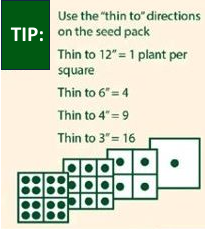
Need to thin your herb garden? Start by checking guidelines on the seed pack.
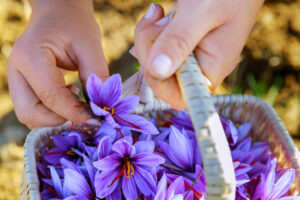
Saffron
Saffron (Crocus sativus) is a perennial purple crocus plant. It’s the most expensive spice in the world coming in at $10 to $20 per gram. There’s a good reason for this. For us to enjoy its sweet, floral, earthy flavors, saffron must be harvested tediously by hand. Each flower holds three thready stigmas (the female part of the flower). And it takes 75,000 saffron flowers to create one pound (454 g) of the valuable spice. You might as well be fancy and grow some yourself. These little crocuses are so short that you can plant six to 12 corms per square foot.
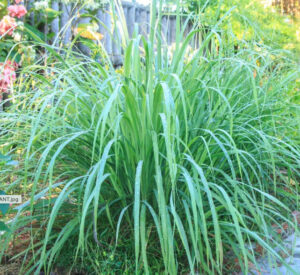 Lemongrass
Lemongrass
Lemongrass (Cymbopogon citratus) is a tender perennial that resembles ornamental grass. It’s loved for its floral, lemony, and ginger-y flavors. Most often used in Southwest Asian cuisine, lemongrass is added to roasted meat dishes, salads, soups, oils, and teas. Most gardeners treat it as an annual, so plant one plant per square foot. In zone 9, lemongrass may die back for the winter and return the following spring. It should also be noted that lemongrass grown in zones 10 and 11 will remain evergreen, growing to 3 – 5 feet tall (1 m – 1.5 m) and 2 feet wide (60 cm). If this is your zone, you can control your lemongrass’ size by trimming (harvesting) leaves regularly and dividing the grass clump in half next spring after the last frost date.
Check Your Zone!
By the way, while most of the herbs listed here are perennials, be sure to check seed packs to see how each behaves in your zone.



